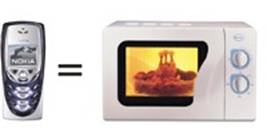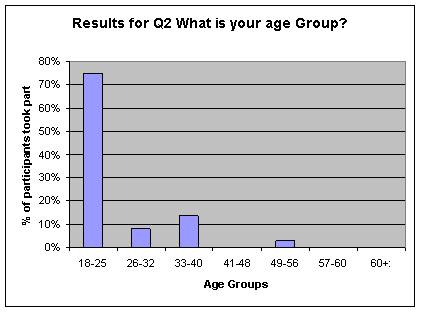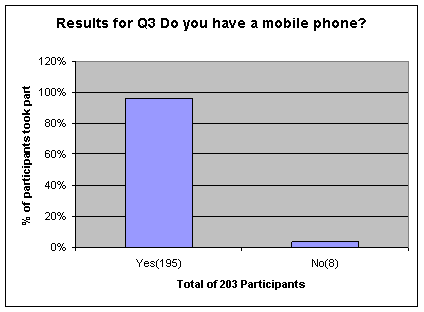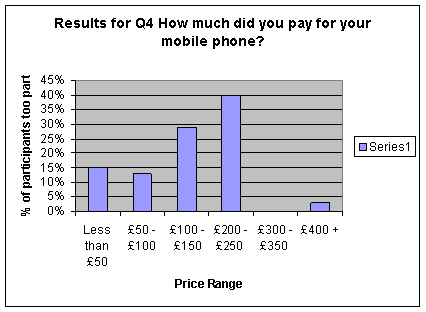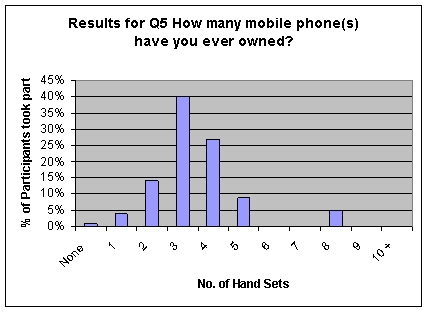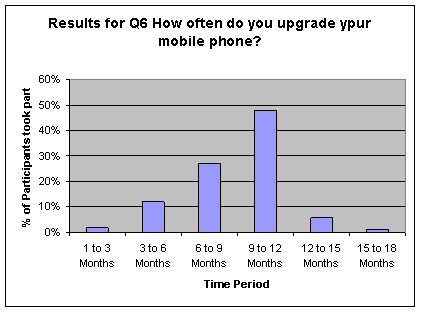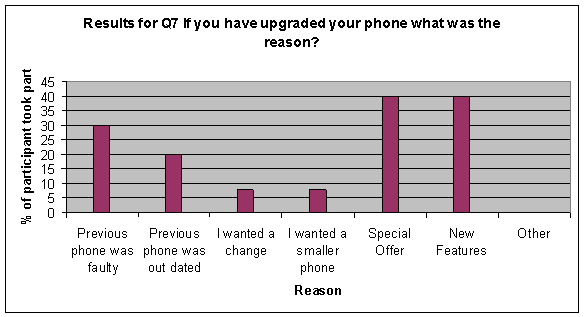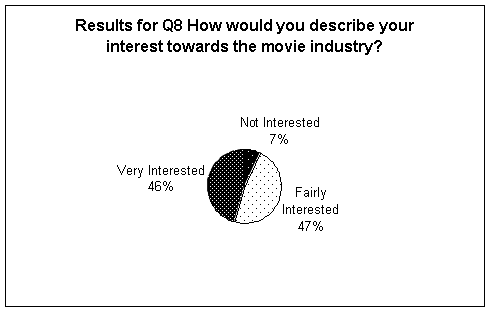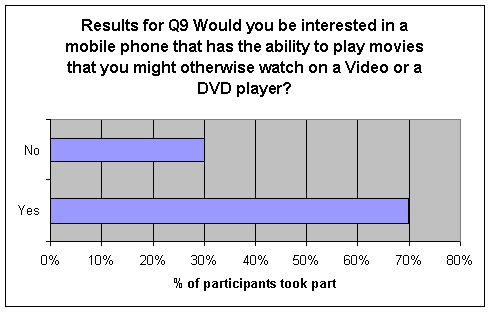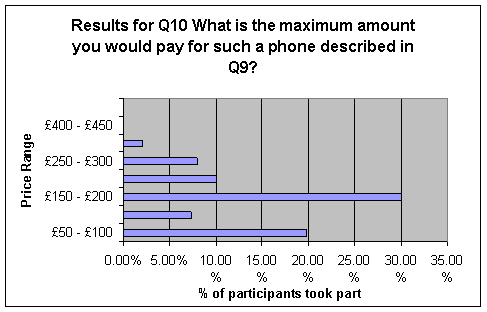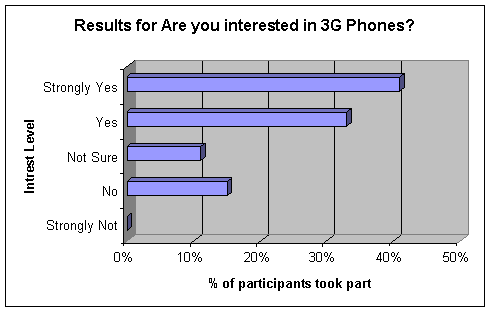This report evaluates and analyses the 3G market, investigating the financial and industrial implications surrounding the 3G market.
A SWOT[1] analysis has been prepared by the author to highlight the strengths, weaknesses, opportunities, and threats associated with the 3G phenomenon.
A PEST[2] analysis has been prepared by the author to highlight the political, economic, social, and technological issues associated with the 3G phenomenon, with a particular emphasis on presenting the issues facing this market area as a whole.
Alongside the aforementioned, an independent research study was conducted to investigate the Nokia TV with the (DVD mobile phone) commercial. The results show just how much such a mobile phone should be priced at and when best to target the Customer.
Research
For primary research the Author placed a questionnaire (See Appendix 1) on the Internet and invited the general public to participate. The aim of the primary research was:
- To see whether the idea of watching a Movie on a mobile phone would generate interest. The idea was inspired by the Nokia TV commercial in which, a woman is seen watching a scary movie on her mobile phone whilst on a bus.
The total number of participants was calculated at 203 over a 3 month period. The findings shall be discussed at a later point in this report under the ‘Results’ section on page 999.
Current Situation
Five companies paid over £22bn ($35bn) between them for licences to operate the heralded 3G third-generation mobile phone services in the UK.
The four main players in Europe – Deutsche Telekom, Vodafone, Telefonica and France Telecom, as well as their strategic partners are using their colossal, cross-border market power to force their suppliers to cut prices.
However large a company may be, handset manufacturers, such as Ericsson, Nokia and Siemens are left with no alternative but to comply with the wishes of the telecom giants’. This is because if they do they are earmarked to make a rather tidy sum of money and not just from the first roll-out of the infrastructure. Even more financial gain will be made at a later stage as systems require maintenance, and upgrades.
Nokia, based in Cannes, France is the world’s top handset maker. They promised in April 2003 at a press conference to deliver its first, new-generation mobile phones by July of this year.
Nokia said it had sent 10,000 third-generation handsets to mobile phone operators such as Vodafone and Orange and equipment manufacturers such as, Ericsson and Nortel Networks for testing. The Finnish heavyweight has arrived late to the European market with its 3G technology.
Nokia’s Arch rivals; Japan’s NEC and US-based Motorola have already delivered their 3G phones in Europe.
Nokia and other wireless operators are waiting for evidence suggesting that Customers would like the new services before investing further in the expensive technology. At present, Nokia is joining its sources with the computer technology giant IBM and also the world’s largest enterprise software maker; Oracle. Reasons for doing this stem deeper into attempting to discover the mass market for mobile phone access to e-mail, calendar and corporate databases.
Despite the fact that some European mobile phone manufacturers have only just begun to unveil their 3G phones, their overseas counterparts have been responsible for securing some of the early deals for quite some time now.
In 2001, the Japanese giant; NTT DoCoMo became the world’s first ever operator to begin selling 3G phones in its home market. Such an accomplishment was achieved through home-grown vendors such as NEC, Matsushita Panasonic and Fujitsu.
Hutchison 3G, is the joint venture controlled by Hong Kong’s Hutchison Whampoa, who has plans to promote Europe’s first commercial 3G as early as next month. Again, this has been achieved through the use of non-European manufacturers.
What is PEST Analysis?
PEST stands for political, economic, social and technological. PEST factors influence the development of the 3G market and thus affect the goals for which it strives.
Compiling a PEST analysis provides valuable information with an opportunity to analyse the 3G market environment. No organisation exists as a unique entity, independent of its environment. Examples of environmental factors in general include events such as the 9-11[3] attack on the World Trade Centre; which in its aftermath cased much economic uncertainty both in America and globally. “Places virtually stood still in September and October – that’s usually a very important period for the US economy,” David Pullman, Wall Street Bond King http://www.guardian.co.uk/september11 (Ref. 03/04/2003)
A more direct environmental factor affecting the 3G market has been the recent SARS[4] epidemic. “The Severe Acute Respiratory Syndrome, or SARS virus outbreak has forced the event organizers of the TD-SCDMA[5] conference in Beijing this week to cancel.” SARS Ko’s 3G Event http://www.3g.co.uk/PR/April2003/5192.htm (Ref.8th April 2003)
Why do a PEST and SWOT analysis?
PEST considers the external environment as a whole; the SWOT analysis (strengths, weaknesses, opportunities, threats) describes the internal influences on the direction of the 3G market. Therefore the PEST and SWOT models combined offer a unique breadth and depth of analysis.
SWOT Analysis
Key Words
| Infrastructure |
| Bluetooth |
| SAFER+, generates 128-bit cipher keys from a 128-bit plain text input. |
| KEY Strengths | Supporting Evidence |
| Market Power | The four main players in Europe – Deutsche Telekom, Vodafone, Telefonica and France Telecom, as well as their strategic partners are using their colossal, cross-border market power to force their suppliers to cut prices. |
| Cellular evolution to high data rates | |
| 802.11b has had initial success in the home and the enterprise | |
| Good peer- to- peer communication system | |
| Number of Bluetooth modules shipped now exceeds 802.11b (TDK Systems Europe information) | |
| 10 Mb/ s system will use 1 Mb/ s channel as a fallback | |
| Good integration and coexistence with 5GHz WLANs | |
| KEY OPPERTUNITIES | Supporting Evidence |
| New Business Opportunities | Ericsson has created a separate Bluetooth business[12], Mads Madsen a spokes person for Ericsson in Sweden said that the new company for which a name has not yet been decided has already begun operations. The company is based in Lund,Sweden. This is where Ericsson has it major Bluetooth research department. “The new company is an expansion of our existing business,” Madsen said. “We expect it to be a profitable business.” |
| Wireless Networking | Bluetooth the much-heralded wireless networking standard is seen as the solution to cutting the cables whilst increasing the connections of devices both at home and at work. |
| Bluetooth and 3G extend the personal network into the Internet | |
| High rate services ensure service continuity with WLANs | |
| Market Opportunity | Generally speaking, 3G services are perceived as a market opportunity of parallel proportions to the Internet itself. This is fundamentally due to the fact that mobile phones, unlike PCs, are easy to use and are just that; mobile. Therefore, Mobiles tend to become part of the everyday lives of those who use them even if the user is not interested in technology. |
| Wi-Fi + 3G = Happy Convergence | |
| Good integration and coexistence with 5GHz WLANs | |
| Every 3G phone will support Bluetooth | |
| Low cost is finally a reality | |
| KEY THREATS | Supporting Evidence |
| Making Money | Wireless providers have paid billions for 3G licences, although they have also invested in a dilemma: how are they to make their money back?As Wireless providers strain and come to terms with the huge burden of dept looming over their heads as a result of inflated prices on many paid for licences, critics have said that “3G will do more to stifle the development of mobile services than it will to revolutionise it” (Jane Wakefield, 2002 BBC News Online technology staff) |
PEST Analysis
Political
The tale encompassing the sales of radio spectrum, especially for the next generation of mobile phones has been one of unpredictable results including widely varying fortunes.
In 2000, the UK Government began to accept bids from 13 companies who wanted to operate a licence to sell next-generation mobile phones. Undeniably, this raised the hopes of other Governments, diminishing their doubts and making it more believable that they too could be in line for a windfall. It raised £22.47bn, a tidy sum to anybody.
However, the companies began to balk from paying the rather huge sums of money for the licences. The only way in which Governments were offered some form of guarantee to make money was to begin in setting a price in advance and thus award the licences on merit through that of a beauty contest.
The UK auction was structured so that each rival bid was designed to be a certain percentage higher than the previous bid. This inevitably resulted in the size of bids spiralling sky high at a rate of over 150 rounds of bidding. In this way, the politics of the situation has made the Government billions of pounds.
Economic
Table 1 below shows the amount each European county paid to operate a licence to sell 3G mobile phones.
| 3G Government Licence Top Prices |
| UK: £22.4bn |
| France: £6.32bn |
| US: £11.24bn |
| Germany: £30.4bn |
| Italy: £7.5bn |
| Netherlands: £1.68bn |
| Poland: £1.9bn |
| Sweden: £26,000 |
| Switzerland: £80m |
| Belgium: £300m |
| Australia: £500m |
| Spain: £12m |
Table 1 3G Government Licence Prices
Source: BBC, (http://news.bbc.co.uk/1/hi/business/1272501.stm) Downloaded 10th April 2003 Scramble for Licences
“The cost of the licences is a bigger issue than people expected,” Tim Sheedy, Senior Mobile Analyst with IDC. “Everyone had an idea what the infrastructure costs would be, because they’ve already built the GSM infrastructure. But the licence costs have come as a major shock.” Tim Sheedy IDC 23rd August 2000
Figure 2 Camera Wireless Phones to be Sold World Wide 2003
Source: http://www.3g.co.uk/PR/Feb2003/4962.htm Downloaded on 10th April 2003
The most recent Strategy Analytics Wireless Device, Strategies report, revealed that “Vodafone’s J-Phone of Japan Leads 18 Million Unit Camera Phone Market”, http://www.europemedia.net/shownews.asp?ArticleID=15123 by David KerrDownloaded on 10th April 2003). The report also concluded that 18 million embedded-camera phones were sold globally during 2002. 13 Million Of those were sold in Japan alone. Figure 2 depicts the global phone sales against period. It is interesting to note that the market has been almost doubling every six months.
Other crucial results from this Strategy Analytics Global Wireless Practice Standpoint conclude that Nokia accounted for 91 percent of GSM camera phone sales globally in 2002. Samsung accounted for 24 percent of CDMA camera phone sales worldwide in 2002.
Social
Around 50 million mobile phones have now been registered in the United Kingdom according to the latest figures making the mobile the most successful consumer product ever.
50 million mobile phones is the equivalent of one phone for every person, with the exception of the very young and the very old. Some people, of course, have more than one phone.
Mobile phones, whilst serving a great purpose, have also triggered a rise in crime. This rise is so large now that it has made the national crime figures much worse than they would otherwise have been.
However, just as every cloud has a silver lining, the good news is that the service providers have at length managed to implement methods preventing stolen phones from being used ever again. Ideally, this should lead to a sharp drop in the crime figures (which the Government will, doubtless, claim credit for).
2002, was the year of camera phones (though they won’t develop into a mass market for a while). 2003 is likely to see serious video games, phones that track your location accurately and the first of the third generation (3G) phones enabling short video films to be taken and emailed to friends.
Such a phenomenon can only be followed suit and will thus include; phones with Wi-Fi (wireless) cards in them. These will enable users to download information at high speed from Wi-Fi “hotspots” in selected places around the country. More importantly, the user will be able to make cheap telephone calls using the internet.
Technological
The purpose of the Cellular telephone today are primarily intended for the purposes of speech and are therefore not particularly renowned for its ability to deliver data. Enhancements have been made to the existing 2nd generation systems (so called 2.5G), which will enable the data to be carried much more easily at higher rates (typically between 28.8kbps and 64kbps, though higher rates are possible), and interestingly where required, as packets rather than circuit switched.
Now, the next generation of cellular telephony (3G) known globally as IMT 2000[13] and in Europe as UMTS[14], has been uniquely designed to carry packet data. Speech is simply treated as a particular data application. 3G systems will allow the end user flexibility in the traffic channel, delivering multiple services with differing bandwidth requirements, and simultaneously if needed. Data rates of up to several hundred kbps will be readily available to the terminal (with so much being done, the end user device is no longer just a mobile phone).
The 2.5G developments are expected to be available in the short term, and certainly within the same period that Bluetooth will make its entrance. Bluetooth will support enhanced 2nd generation as well as 3G systems in the delivery of a wide range of services. With the development of such broad capabilities, it will be rather tempting to make use of the 2.5 and 3G systems to support every new application and even some of the old ones too.
Results
The total number of participants was 203 over a 3 month period.
General Demographics
Figure 3
Source: Primary research conducted on the Internet.
Analysing Figure 3
Figure 3 shows the distribution of gender among the participants to the survey.
Figure 4
Source: Primary research conducted on the Internet.
Analysing Figure 4
Figure 4 shows the distribution of the age groups. 75% of participants belong to the 18 to 25 age group range. Since the survey was carried out online[15] it could mean that this age group is online in more numbers than other age groups.
Figure 5
Source: Primary research conducted on the Internet.
Analysing Figure 5
Figure 5 shows how out of the 203 participants, 195 of them had a mobile phone and only 8 did not. This goes to show how saturated the mobile phone market has become. It’s not a wonder that mobile phone manufacturers are continually trying to revamp mobile phones to keep the industry in profit.
Figure 6
Source: Primary research conducted on the Internet.
Analysing Figure 6
Figure 6 shows how much participants to the survey paid for their mobile phones. It is interesting to note that 40% of people asked paid between £200 and £250.
Figure 7
Source: Primary research conducted on the Internet.
Analysing Figure 7
Figure 7 shows how much the number of mobile phone handsets participants have owned. It is particularly important to note that 5% of people are on the 8th handset, because these are the people that have been found to upgrade their phones regularly.
Figure 8
Source: Primary research conducted on the Internet.
Analysing Figure 8
Figure 8 shows 9 to 12 months is the most frequent time period for upgrades.
Figure 9
Source: Primary research conducted on the Internet.
Analysing Figure 9
This shows upgrades, special offers and new features as being the reason for upgrading. This accommodates Figure 9 which shows that most upgrades occur every 9 to 12 months which is the time most mobile phone operators release their new contract services and long awaited phones.
Subject Specific Questions
Figure 10
Source: Primary research conducted on the Internet.
Analysing Figure 10
Figure 10 shows how the participants responded to indicate their interest towards the movie industry. 46% were very interested and a further 47% were fairly. This indicates a positive interest towards the movie industry.
Figure 11
Source: Primary research conducted on the Internet.
Analysing Figure 11
Figure 11 shows that 70% of the people surveyed are interested. This means that the Author has successfully archived the aim set out above.
Figure 12
Source: Primary research conducted on the Internet.
Analysing Figure 12
Figure 12 shows the maximum amount people surveyed are willing to pay for a phone that is described in Q9.
Figure 13
Source: Primary research conducted on the Internet.
Analysing Figure 13
Figure 13 shows the response to the surveyed participant’s interest toward 3G phones.
Evaluation
Market Direction
The four main telecom players in Europe and their strategic partners are using their colossal, cross-border market power to force their suppliers to cut prices. As a result the already hard up mobile phone manufacturers are finding it even harder to make a profit.
Everyone wants to see 3G Work
Everyone wants 3G to work successfully, especially the 3G licence holders. They have invested a large amount of money into the project and have as yet seen no return to recuperating seemingly lost investment. Government politics have made the situation somewhat worse by inflating prices in the initial stages. Despite spending more than 100 billion euros (US$107 billion) on 3G licences in 2000, equipment makers have delayed commercial 3G launches. They are awaiting evidence to suggest to querying Customers who want to know exactly what services are available before they further invest into the costly technology infrastructure.
The Authors primary research questionnaire results provide evidence to suggest that Customers are indeed looking for new services. Figure 13 shows 40% of the surveyed participants indicating very strong interest towards 3G phones. A further 33% displayed a strong interest also.
Concluding Primary Research Findings
When the surveyed participants were asked Q9. Would you be interested in a mobile phone that has the ability to play movies that you might otherwise watch on a Video or a DVD player? See Figure 11, a staggering 70% indicated that they are interested. To add substance to this idea the next question in the questionnaire asked; What is the maximum amount you would pay for such a phone?Figure 12 shows 30% of Customers are willing to pay anything between £150 to £200 and 8% willing to pay between £250 to £300 and 20% willing to pay between £50 to £100.
This suggests that the mobile phone operators can develop a there-tier system of phones to cater for all.
The Author recommends a greater quantity of individuals be surveyed as 203 participants are for the purposes of adding further weight to the results.
Opportunities Arising in the Future
The majority of the Terrestrial Television channels use the VHF spectrum with licences that are due to expire in 2015. Digital Interactive TV is already here and can be accessed via a set-top box opening a whole new world of interactivity.
We must wait and see if history repeats itself once again and if the government resorts to the same bidding political tactics that has hindered the delivery of 3G technology, resulting in inflated licence prices.
Figure 14 3G BTS World Market Share 2002 to 2007
Source: 3G Base Station Market Growing http://www.3g.co.uk/PR/April2003/5314.htm (Ref. 04/05/03)
Figure 14 Shows the projected growth in the 3G World Market from 2002 to 2007.
An unstable economic climate, ever changing customer needs, and up-and-coming technology continually stirs up market turbulence. The driving force in this new marketplace is the consumer. The driving factor is technology[16]. It may already be too late for 3G licence operators to even recover returns on their investment.
“…By the time operators roll out the monumentally over-hyped 3G, their financial world will be different: Their credit ratings will have been battered, cruise ships-full of cash will have been spent, and the economic outlook will have changed….” The Future of 3G| Nick Selby http://www.nickselby.com/articles/technology/3g.html (Ref 01/05/2003)
[1] SWOT, Strengths, Weaknesses, Opportunities and Threats
[2] PEST, Political, Economic, Social and Technological
[3] September 11th 2001 – America’s War against Terrorism, 9/11 University of Michigan – http://www.lib.umich.edu/govdocs/usterror.html (Ref. 3/04/03).
[4] SARS, Severe Acute Respiratory Syndrome
[5] TD-SCDMA, stands for Time Division Synchronous Code Division Multiple Access
[6] http://www.privateline.com/Bluetooth/Bray.pdf
[7] Faraday Cage “The Faraday Cage Effect (named after its discoverer) means that the electric charge on a conductor sits on the outer surface of it. Therefore, no electrostatic field is present within the conductor” – http://www.rfsafe.com/research/rf_radiation/shielding_rf_hazards/faraday_cage.htm
[8] Base Stations are masts that mobile phone operators use to enable coverage of their network.
[9] Giga Watt is equivalent to 1024 Mega Watts.
[10] Ad hoc networks are a new wireless networking paradigm for mobile hosts http://citeseer.nj.nec.com/zhou99securing.html
[11] SAFER+, generates 128-bit cipher keys from a 128-bit plain text input.
[12] Ericsson creates separate Bluetooth business – News Bulletin by John Evers, Amsterdam correspondent for the IDG News Service, an InfoWorld affiliate. http://archive.infoworld.com/articles/hn/xml/00/11/22/001122hneric.xml
[13] IMT-2000 stands for International Mobile Telecommunication 2000
[14] UTMS, Universal Mobile Telephone System
[15] Online, on an Internet Web site
[16] Discovering the Process of Mass Customization: A Paradigm Shift for Competitive Manufacturing Report L.J. Anderson
